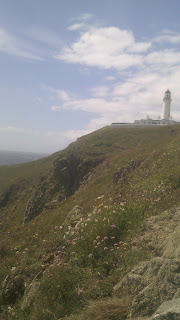Monday, 6 July 2015
Foghorn on the Mull of Galloway
There is a foghorn on the slope below the lighthouse, shown in the lower photograph. Light is scattered by fog so it is not possible to see the light beam in fog. But sound can travel through fog. Sound is a longitudinal mechanical wave. Air particles oscillate backwards and forwards. There is a certain amount of viscosity is any medium. This opposes the motion of the particles. Hence the longitudinal oscillations are slightly damped at each point and energy is dissipated. In other words, the perceived volume will decrease. If there were no viscosity, it would be an inverse square law like light. So the volume of sound heard must decrease faster than this. It turns out that such attenuation is dependent on frequency. The lower the frequency, the less the attenuation. Lower notes should travel further for the same initial volume - so foghorns were always low notes. I say were because they've all been turned off in the UK! See https://en.wikibooks.org/wiki/Engineering_Acoustics/Outdoor_Sound_Propagation for some of the theory.

